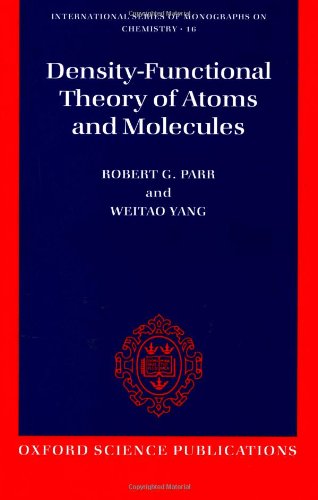Density functional theory of atoms and molecules book
Par ellis mary le jeudi, juillet 21 2016, 16:36 - Lien permanent
Density functional theory of atoms and molecules by Robert G. Parr, Yang Weitao


Density functional theory of atoms and molecules Robert G. Parr, Yang Weitao ebook
ISBN: 0195042794, 9780195042795
Publisher: Oxford University Press, USA
Format: djvu
Page: 338
STM constant-current image of a naphthalocyanine molecule, recorded with a CO-terminated tip. For this to work, however, computers using particular codes and algorithms have to both the molecular dynamics and the electron structure in one go as impossible. These results present a significant challenge/ benchmark for electronic structure methods (such as density functional theory) which claim to be able to calculate accurately such quantities. With its help, he wanted to describe the material that surrounds us through the movement of the atoms, using classical molecular dynamics. Specially, the present introduction of short cutoff radius pseudopotentials enables the hydrogen EOS to be available in the range Newer Post Older Post Home. In the multireference density functional theory, relevant fluctuation channels for the Josephson coupling between superconducting layers include the interlayer pair hopping derived from the Coulomb repulsion. One of the fundamental atomic and molecular processes that takes place in strong laser fields. Molecular orbitals are then expanded in terms of atomic orbitals as linear combination of atomic orbitals (LCAO). Density functional theory of atoms and molecules. Materials Science - Books Atom Probes; Atomic Force Microscopes (AFM) Electron Beam Sources; Fiber Analyzers;. That meant combining the BO approximation with so-called quantum mechanical Density Functional Theory (DFT), which determines the structure of the electrons. In this Rapid Communication, we extend the time-dependent density-functional theory (TD-. Recent experiments with diatomic molecules [3,4] of the target molecules. Wide range equation of state (EOS) for liquid hydrogen is ultimately built by combining two kinds of density functional theory (DFT) molecular dynamics simulations, namely, first-principles molecular dynamics simulations and orbital-free molecular dynamics simulations. Over the past decade they have developed several high resolution microcalorimeters which allow accurate determination of the binding energies of different atoms and molecules to specific surfaces.